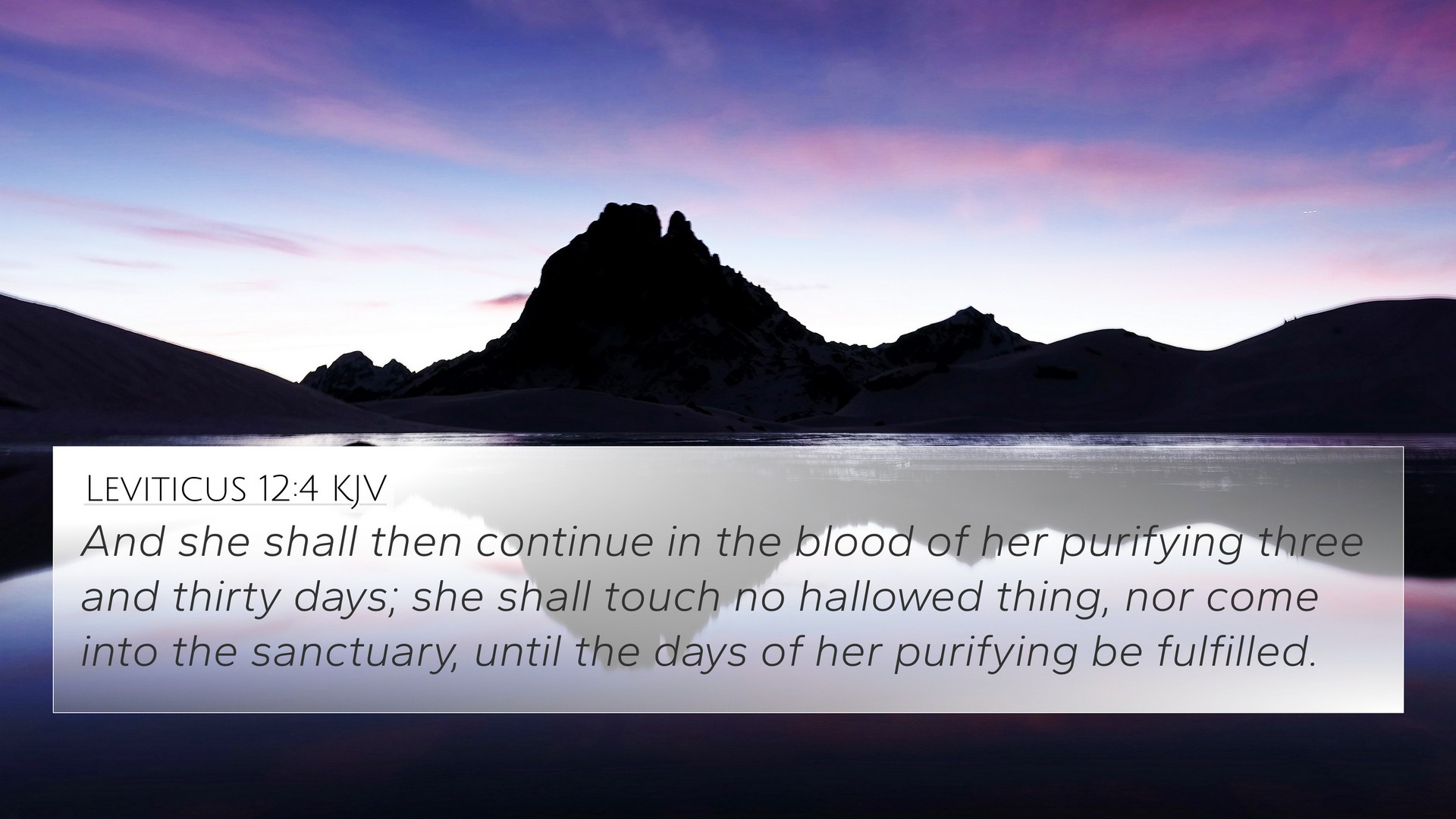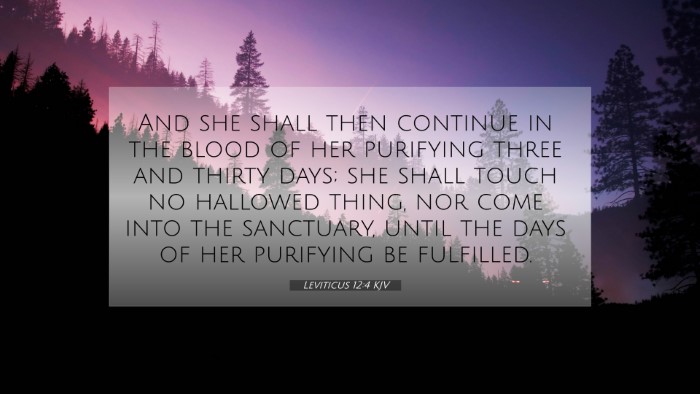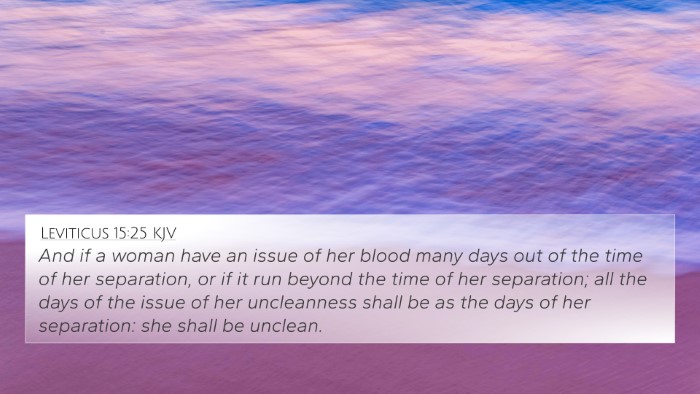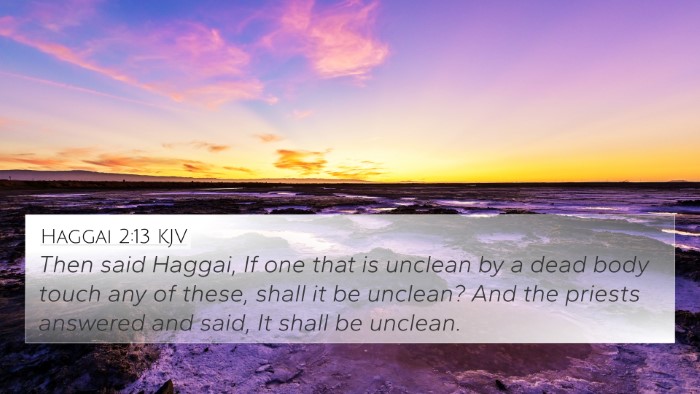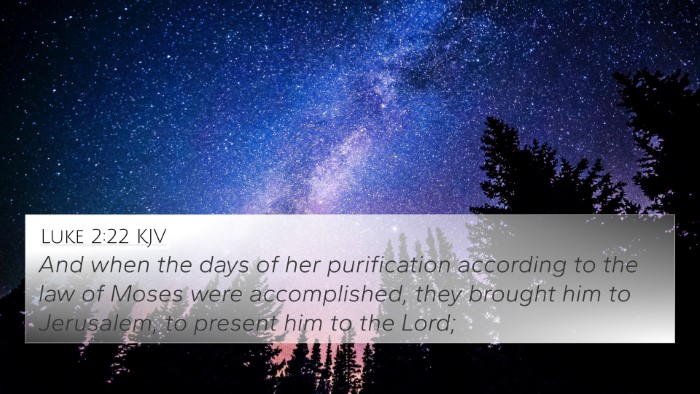Understanding Leviticus 12:4
Leviticus 12:4: "And she shall continue in the blood of her purifying three and thirty days; she shall touch no hallowed thing, nor come into the sanctuary, until the days of her purifying be fulfilled."
Summary of Commentary Insights
This verse deals with the purification process required for a woman after childbirth, delineating both the time frame and the conditions under which she must remain separate from sacred activities.
- Matthew Henry: He emphasizes the importance of the period of purification, which serves as a physical reminder of the separation from ritual and ceremonial practices during a time of transition. This separation was not only for hygiene but carried profound spiritual significance, reinforcing the idea of holiness and the necessity for spiritual readiness before entering sacred spaces.
- Albert Barnes: He notes that the period of thirty-three days after the birth of a male child is intended to represent a time of rest and reflection. Barnes highlights that this command not only points toward the seriousness of sin and impurity but also alludes to the familial and societal implications of childbirth, where devotion to God and family needs distinction.
- Adam Clarke: Clarke elucidates the ceremonial aspects of this purification, arguing that it illustrates both the physical and spiritual cleanliness expected of the people of God. He stresses that, despite the cultural context, the underlying principle emphasizes community harmony and the importance of maintaining a boundary between the sacred and the everyday life of the individual.
Thematic Connections and Cross-References
Leviticus 12:4 connects to several significant themes in the Bible, including purification, holiness, and the significance of childbirth. Below are some relevant cross-references:
- Leviticus 15:19-30: Discuss the laws of purification regarding bodily discharges, reinforcing the theme of ritual cleanliness.
- Numbers 19:11-22: Details the purification process involving the red heifer, further emphasizing the necessity of cleansing before approaching God.
- Isaiah 6:5-7: Represents a vision of purity and holiness when Isaiah acknowledges his sinfulness and is purified through coal from the altar.
- Hebrews 10:19-22: Connects the Old Testament purification rituals to the New Testament understanding of purification through Christ's sacrifice.
- Luke 2:22: The presentation of Jesus at the temple, reflecting the context of ceremonial purification after childbirth.
- 1 Corinthians 6:19-20: Discusses the body as a temple, mirroring the theme of holiness and the need for personal purification.
- Psalm 51:10: Where David requests a clean heart, connecting inner purity with the external ceremonial laws.
Significance in Biblical Context
This verse elucidates a significant aspect of the Levitical laws governing the lives of the Israelites – a reminder that holiness and purity are essential in the relationship with God. The laws can be interpreted as a systematic approach to spirituality, embodying the regimented life of the faithful.
Understanding Leviticus 12:4 through the lens of cross-referencing Biblical texts allows us to draw connections between various parts of Scripture that inform and deepen our understanding of purification and holiness in both the Old and New Testaments.
Practical Application of Cross-Referencing
Engaging in cross-referencing, such as those provided above, creates a rich dialogue throughout the Bible, enhancing Bible study and understanding.
To utilize cross-references effectively, consider the following tools and methods:
- Use a Bible concordance to identify related verses.
- Explore Bible cross-reference guides that highlight thematic connections.
- Practice cross-reference Bible study by identifying contrasting or complementary verses.
- Utilize digital tools that offer a comprehensive Bible cross-reference system.
- Engage in inter-Biblical dialogue during personal study or group discussions.
Conclusion
In summary, Leviticus 12:4 serves as a crucial reminder of the significance of purity and readiness to meet God, encapsulated within the traditions that the Israelites adhered to. Through cross-referencing this chapter with relevant verses, one can glean deeper insights into not only the laws themselves but also the broader themes of holiness that stretch across the entirety of Scripture.
